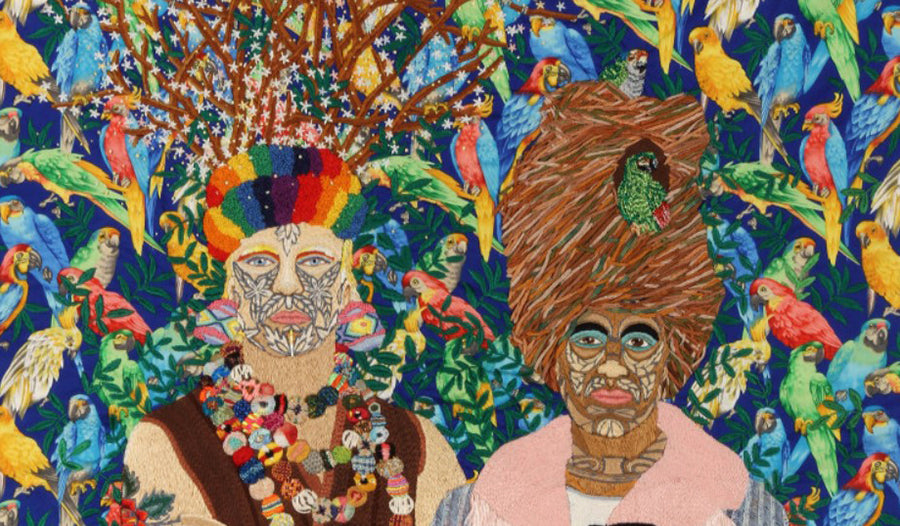
Over The Rainbow

We're celebrating LGBT+ History month here at Selvedge, an annual month-long observance of lesbian, gay, bisexual and transgender history, and the history of the gay rights and related civil rights movements.
Chiachio & Giannone refer to themselves as ‘one artist with two heads and four hands.’ Their textile paintings challenge the heteronormative codes in society, especially the concept of family, while simultaneously delighting the viewer with humour, colour, and exquisite handwork.
In 2003, the painters, Leo Chiachio and Daniel Giannone, began a collaborative partnership in life and work in their home city of Buenos Aires. At that time, the model Argentine family did not include two gay men and a dog. It wasn’t until 2010 that Argentina became the first country in Latin America to legalise same sex marriage, and Chiachio & Giannone addressed the issue by embroidering a series of family portraits, placing themselves and their beloved dog, Pioline, within a series of tableaux. They represent themselves as ‘others’ masking (or possibly revealing) their true selves in a composition reminiscent of traditional family portraits. The amusing and highly detailed pictures depict Leo and Daniel as various characters including Guarani Indians, geishas, Chinese babies, Day of the Dead skeletons, and even animals as they broaden the discourse on identity and family.

Image: Chiachio and Gionnone, Familia en la Fontana di Trevi (2012). Hand embroidery with cotton thread on fabric, 110 x 170cm.
Discarding the notion that family is a group related by blood or created through marriage between a man and a woman, Chiachio & Giannone expand the concept by paying homage to brethren LGBTQ+ who metaphorically share their DNA as well as other artists who typically work outside the classic white heterosexual male canon of fine art. These include women who may have been overshadowed by their more successful spouses such as Sonia Delaunay or Anni Albers as well as outsider artists who embrace nontraditional materials or domestic crafts. Chiachio & Giannone consider these other artists as the grandmothers or grandfathers within their art family. For a recent exhibition in Buenos Aires they used dye sublimation to print sheer fabrics in the style of Bauhaus textiles that were then hung in multiple layers as an entrance to their other work; the visitor was thus softly challenged to confront this craft history which subsequently created a way of viewing the elaborate embroidered paintings inside the gallery.
Found textiles are often used as a base for their embroidery, either repurposed or discovered while traveling. Many of these kitschy novelties add an additional comic layer to their embroidery such Picos Gemelos in which a blanket imaged with two deer in the forest is further adorned with textile patterns and pompoms. Alexander Henry fabric is the starting point for several works including Calaverita in which they portray themselves as Day of the Dead figures and Bomberos where they exploit gay iconography attributed to classic Village People stereotypes. In Bomberos, Leo, Daniel and Pioline are framed in a ring of fire surrounded by beefy firemen ready to rescue them.

Image: Chiachio and Gionnone, Lyonnais (2016). Hand embroidery with cotton thread, 122 x 148cm.
They also will print their own backgrounds when it suits their message as in La Selva de Constantin where they silkscreened bold images of garden foliage as a backdrop to embroidered monkey bodies sporting Leo’s and Daniel’s faces. They were drawn to textiles as a form of artistic expression because it not only allowed them the opportunity to discover something new about painting but provided a way of working collaboratively that removed the individual signature—it was impossible to recognise the owner of each individual stitch. They see their work as painting with a needle and thread. While they are best known for their elaborate embroidery, they also incorporate other handcrafts in their work such as quilting, patchwork, applique, and even porcelain. They have a genuine love of making things and the active participation in their own laborious work—one piece may take two, three years to complete—honours the legions of anonymous makers implanted within the domestic tradition of needlework.
--
The excerpt above was written by Susan T. Avila and can be found in Issue 92 Comfort.
You can hear more from Leo and Daniel and the rest of the exciting panel of speakers from our Sew Far So Good talk. Find out how to listen to the recording here:

